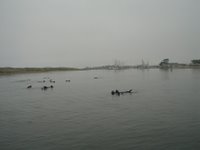
 Sea Otter Census
Sea Otter CensusThe task for my group today was to take an entire census of the population of sea otters in the Elkhorn Slough and Moss Landing Harbor. The method for the census was to travel down the 7 miles of the Slough and then turn around and begin the census count. On the slow trip back data was collected for each sea otter siting. The data consisted of the number of otters in the sighting, sex and approximate age, the location in the Slough, latitude and logitude of the sighting (using GPS), distance from the boat, and a bearing determined with a compass. There was a team of three collecting the data. Each member was assigned a particular task. I was sitting on the bow of the boat taking down the data and checking the GPS for latitude and longitude while others called out the other pieces of data that needed to be recorded. It was not too difficult when only a few sea otters were spotted in an area. The challenge began when we returned to the harbor and there were 35 sea otters gathered in a "raft" and all the information had to be gathered on all of the otters in the short time that the boat was passing by the large group. It was difficult to listen and record all the data quickly. It takes a lot of team work to accomplish this type field work.
Questions:
1. What does the term census mean?
2. What is meant by the term "raft" in this post?
3. The term "GPS" has been used in 2 posts. What does it stand for and how does it work.
4. How do you determine the approximate age of a sea otter?
Good Luck and have fun finding the answers to these questions!

0 Comments:
Post a Comment
<< Home